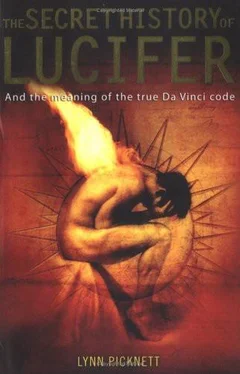22. For those who appreciate what may well simply be a coincidence - or perhaps a Cosmic Joke - `Anfortas' is an exact anagram of `For Satan'. Of course it would be considerably more impressive if in French.
23. Rahn, p. 18.
24. Ibid., p. 21.
25. Ibid., p. 22.
26. Ibid., p. 91.
27. For details, see Andrew Collins' haunting and important book 21st-Century Grail, London, 2004.
28. For the classic exposition of the theory that `sangreal' actually means `holy blood' see Michael Baigent, Richard Leigh and Henry Lincoln, The Holy Blood and the Holy Grail, London, 1982. For the fictional version par excellence, there is, of course Dan Brown, The Da Vinci Code, New York, 2003.
29. Wolfram von Eschenbach, Parzival, London, 1980, pp. 232-3.
30. The Mabinogion, trans. Gwyn Jones and Thomas Jones, London, 1949, p. 192.
31. Ibid., p. 218.
32. Tobias Churton, The Golden Builders, Litchfield, 2002. See also Picknett, Appendix.
33. Wolfram, p. 240.
34. Ibid., p. 396.
35. Andrew Collins, 21st-Century Grail, London, 2004.
36. Father Philippe Devoucoux du Buysson, in Dieu est amour, no. 115 (May 1989), quoted in Picknett and Prince, p. 123.
37. Colin Wilson, The Occult, London, 1973, p. 272.
38. Michael Baigent and Richard Leigh, The Inquisition, London, 2000, p. xv.
39. Marie-Humbert Vicaire, Saint Dominic and His Times, trans. Kathleen Pond, London, 1964, p. 146. Quoted in Baigent and Leigh, p. 17.
40. Walter L. Wakefield, Heresy, Crusade and Inquisition in Southern France 1100-1250, London, 1974, p. 208.
41. Ibid., p. 212.
42. Baigent and Leigh, p. 19.
43. Wakefield, p. 216.
44. Baigent and Leigh, p. 25.
45. Wakefield, p. 224, quoted in Baigent and Leigh, p. 26.
46. Stoyanov, p. 178.
47. Baigent and Leigh, p. 28.
48. See Lynn Picknett, Clive Prince and Stephen Prior, Friendly Fire: The Secret War Between the Allies, Edinburgh, 2004, pp. 54-5, 56-61.
49. Summers, p. 20.
50. H.T.F. Rhodes, `Black Mass', Man, Myth and Magic, London, 1971, No. 10, pp. 274-8, quoted in Lynn Picknett and Clive Prince, The Templar Revelation: Secret Guardians of the True Identity of Christ, London, 1997, p. 86.
51. Barbara Walker, The Woman's Encyclopedia of Myths and Secrets, New York, 1983, p. 1079.
52. Ronald Pearsall, The Worm in the Bud, New York, 1969, p. 209, quoted in Walker, p. 643.
53. Vern L. Bulloch, The Subordinate Sex, Chicago, 1973, p. 176, quoted in ibid.
54. Revelation 22:2.
55. Joseph Campbell, The Mask of God: Creative Mythology, New York, 1970, p. 159.
56. Walker, p. 640.
57. Charlene Spretnak (ed.), The Politics of Women's Spirituality, New York, 1982, p. 269, quoted in ibid., p. 644.
58. Walker, p. 644.
59. Mary Daly, Beyond God the Father, Boston, 1973, p. 69.
60. Although a precise number can never be known, the total number of `witches', both male and female, who suffered and died at the hands of the Church has been drastically downgraded from estimates as high as 5 million to around 100,000. Yet given the relatively scanty population of Europe during that time, and the fact that whole villages were decimated and never recovered, it is still a large number. And it need hardly be said, even the revised figure is 100,000 too many.
61. Walker, p. 1079.
62. Barbara Rosen, Witchcraft, New York, 1972, pp. 296-7.
63. Walker, p. 170.
64. Antoinette Bourgignon, La Vie exterieure, Amsterdam, 1683, quoted in Summers, p. 71.
65. My notes at this point read incredulously: `Is he mad?' After a while, I gave up making similar comments. It would have taken up far too much time.
66. Summers, p. 71, references Delrio. Disquistiones magicae, 1. V. sect. 4. T. 2. `Non eadem est forma signi, aliquando est simile leporis uestigio, aliquando bufonis pedi, aliquando araneae, uel catello, uel gliri.'
67. Summers, p. 45.
68. Ibid., p. 226.
69. The most wonderfull ... storie of a ... Witch named Alse Gooderidge, London, 1597, quoted in Summers, pp. 75-6.
70. Rossell Hope Robbins, Encyclopedia of Witchcraft and Demonology, New York, 1959, p. 42.
71. Ribet, La mystique divine, 111. 2. Les Parodies diaboliques: `Le burlesque s'y mele a l'horrible, et les puerilites aux abominations.' Quoted in Summers, p. 110.
72. Summers, p. 111.
73. Ibid., p. 121.
74. Robbins, pp. 500 and 540.
75. Peter Haining, Witchcraft and Black Magic, London, 1971, p. 103.
76. Sir Walter Scott, Letters on Demonology and Witchcraft, London, 1884, pp. 166-8.
77. Apparently there are problems with his translation, although another one is in the pipeline.
78. Heinrich Kramer and Jakob Sprenger, Malleus Maleficarum (Hammer of the Witches), 1485.
79. Robbins, pp. 303-4.
80. Ibid.
81. Ibid., pp. 18 and 508.
82. G.G. Coulton, Inquisition and Liberty, Boston, 1959, pp. 154-5, quoted in Walker, p. 1006.
83. C. L'Estrange Ewen, Witchcraft and Demonianism, London, 1933, pp. 122-3.
84. Robbins, p. 501.
85. Ibid.
86. Walker, p. 1005, referencing Jean Plaidy, The Spanish Inquisition, New York, 1967,p. 157.
87. Robbins,p.509.
88. See, for example, www.nd.edu/-dharley/witchcraft/Malleus.html.
89. Ibid.
90. Henry Charles Lea, The Inquisition of the Middle Ages, New York, 1954, unabridged version, 1961, pp. 815 and 831, quoted in Walker, p. 1080.
91. Terry Davidson, Conjugal Crime, New York, 1978, p. 99.
92. Amaury de Riencourt, Sex and Power in History, New York, 1974, p. 219.
93. Walker, p. 593.
94. Kramer and Sprenger, Part 1, q. xi: Nemofidei catholicae amplius nocet quam obstetrices.
95. Robert Knox Dentan, The Semai: A Nonviolent People of Malaya, New York, 1968, pp.96-8.
96. Bulloch, p. 177.
97. Wolfgang Lederer, The Fear of Women, New York, 1968, p. 150.
98. Ibid.
99. Walker, p.656.
100. Ibid.
101. Andrew D. White, A History of the Warfare of Science with Theology in Christendom, 2 vols., New York, 1955, vol 1, p. 319.
102. Walker, p. 656, quoting George B. Vetter, Magic and Religion, New York, 1973,p.355.
103. Ibid.
104. Ibid., p. 1008.
105. Robbins, p.108.
106. Summers, p. 63.
107. Ibid., p. 256.
108. For a particularly thought-provoking analysis of the Helen Duncan affair, see Manfed Cassirer's Medium on Trial: The Story of Helen Duncan and the Witchcraft Act, Stanstead, 1996.
Chapter Five Pacts, Possession and Seance Rooms
1. According to Jeffrey Burton Russell in Lucifer: The Devil in the Middle Ages, New York, 1984, p. 80 (note): `Hincmar interjects the tale into his Divorce of Lothar and Teuberga, written about 860 (MPL 125, 716-25).'
2. Ibid.
3. Ibid., p. 81.
4. Ibid., p. 82. Russell adds in note 41: `Since mouffle is colloquial French for "slob" an element of anti-Flemish prejudice seems present here.'
5. Jean Plaidy, The Spanish Inquisition, London, 1967, p. 171 ff.
6. Johannes Weir.
7. Goethe's Faust, Part One, 1808, translated by Philip Wayne, who also wrote the Introduction to the 1949 Penguin Edition, p. 15.
8. It is through its Italian form, nigromancia, that it came to be known as `the Black Art'.
9. www.satansheaven.com/necromancy.htm.
10. 1 Samuel 28.
11. Goethe, Faust, p. 40.
12. See in previous chapter.
13. Lewis Mumford, Interpretations and Forecasts, New York, 1973, p. 302.
14. The Devils, 1971, directed by Ken Russell, starring Vanessa Redgrave and Oliver Reed.
15. T. K. Oesterreich, Possession, Demoniacal and Other, New York, 1966, pp. 49-50.
16. Grillot de Givry, Witchcraft, Magic and Alchemy, New York, 1971, pp. 118-19.
17. Montague Summers, The History of Witchcraft, London, 1925, p. 73.
Читать дальше












